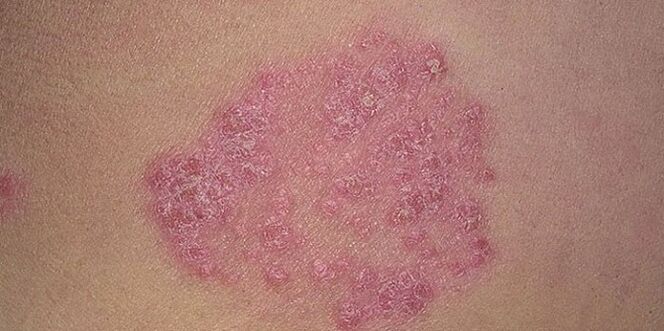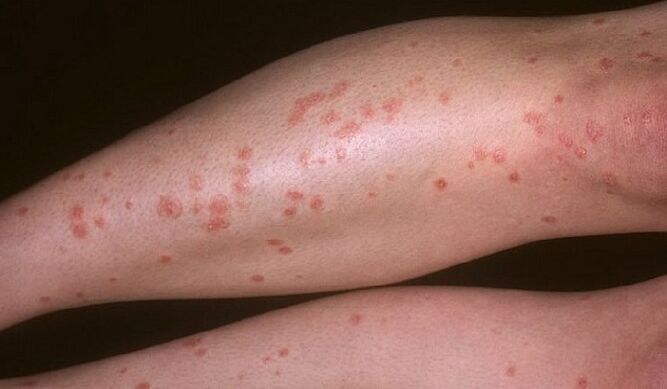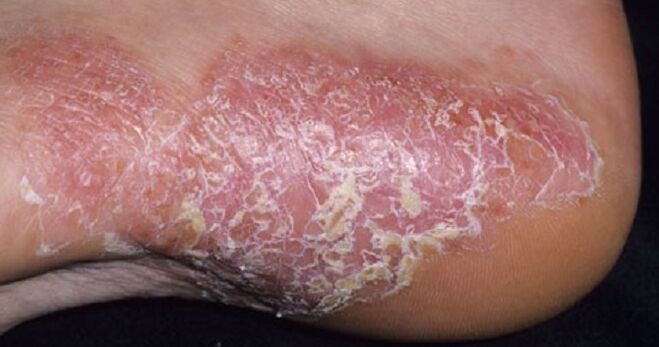Psoriasis of the legs is a skin disease in which itchy papules, spots or pustules appear on certain parts of the extremities. It grows over time and attaches to the boards. The disease is incurable and chronic. A well-designed complex therapy helps to quickly eliminate the symptoms of psoriasis in the legs. Therefore, you should not prescribe treatment to achieve a stable remission (complete or partial cleansing of the skin from the elements of the rash).
Causes of pathology
Scientists still do not understand why psoriasis appears on the legs and other parts of the body. Many researchers have linked psoriatic skin rash to a genetic defect in the cells of the epidermis and subsequent overactivity of the immune system. This pathological condition occurs as follows:
- As a result of skin dysfunction, keratinocytes (which make up 90% of epidermal cells) do not have time to mature, but multiply rapidly, which leads to changes in the structure of individual areas. skin.
- In response to such a failure, the body's immunity sends T-lymphocytes (killing cells) and macrophages (eating cells) to destroy immature and pathologically altered keratinocytes.
- As a result of the accumulation of a large number of immune cells and keratinocytes in the upper layers of the epidermis, the skin begins to grow and peel. No drug can help to completely normalize the regenerative functions of the skin.
The progression of psoriasis in the legs is facilitated by a bacterial infection that can penetrate the skin through small scratches, as well as a disturbed hormonal background, contact allergic dermatitis and a number of other external factors.
How psoriasis looks on the feet depending on the type of disease
Psoriatic lesions on the feet and knees can look different from person to person. This factor is explained by the course of the disease. In addition, the skin of the feet may develop one or more forms of psoriasis, including palmar-plantar, general (vulgar), tear-shaped, punctate, as well as nail and articular psoriasis.
Psoriasis of the feet and legs
Elements of psoriatic rash can be localized in different parts of the skin of the legs:
- on the knees;
- on the legs;
- on the heels;
- in the thighs.
Psoriasis of the lower leg, foot, knee joint, and inner thigh begins with the appearance of single red papules and severe itching (typical for the spot and vulgar form of the disease) or small spots of pink and purple color. with psoriasis in the form of tears).

In the first case, the rash elements protrude slightly above the surface of the skin, differ in density, and have a silvery tip, which breaks off when scratched with a nail. Over time, the papules grow, and those close to each other merge into a single plaque. As a result, they completely cover the skin of the knees or cover hard areas of skin from the knees to the feet. Peeling is visible on the surface of the boards.

In the early stages, the tear-shaped elements of psoriatic rash affect the entire skin of the feet with small rashes of the same type. Later, as the disease progresses, single spots merge into groups and cover large areas of the skin of the feet. Such psoriatic lesions rarely occur in the ankles.

Palmar-plantar psoriasis often develops in the lower part of the foot. Rash elements appear in the form of small spots and pustules on the inflamed skin of the feet with clear borders and yellow sterile content. If the pustules on the legs open, the fluid from them flows, dries and forms a yellowish crust, and the ulcers at the bottom also dry out.
Non-explosive pustules are covered with dry scales. Gradually, they grow into groups, and the scaly layer begins to compress the skin strongly, which causes discomfort when walking. The skin around the boards becomes thick and dry, cracking. Through such cracks, an infection usually penetrates the deeper layers of the skin, after which the skin begins to cry and rot.
Psoriatic arthritis
In most cases, psoriasis of the plaques of the legs causes psoriatic damage to the joints. This arthritis is divided into 5 types:
- Symmetrical - simultaneous inflammation of the knees, hips, ankles or paired joints of the legs.
- Asymmetric - pathological changes affect both large and small joints, for example, the joints of one knee and the joints of the fingers.
- Inflammation of the distal joints - swollen small joints in the fingers close to the nails.
- Spondylosis - Arthritis affects the lumbosacral spine, resulting in pain in the hips and lower extremities.
- Deformative arthritis is a rare inflammatory pathology in which the small joints of the fingers are completely destroyed.
The skin on the swollen joints swells, turns purple-blue and reddens.
Damage to nail plates
Psoriatic nail damage occurs against the background of:
- Psoriatic arthritis in 80-90% of cases;
- Vulgar or pustular psoriasis in 50-60% of cases.
In 5-10% of clinical cases, psoriasis of the toenails is primary, ie it appears spontaneously, not before psoriatic lesions of the joints or skin of the feet.
Initially, generalized psoriasis of the soles of the feet or psoriatic inflammation of the distal joints of the toes causes pathological changes in the skin of the periungual region. It then spreads to the pathological nail bed or affects the nail plate that extends over it. There is a deformation in the nail - the formation of holes, transverse lines - and a change in the color of the board.
Similar psoriasis symptoms in women are rare in adolescence, and most often the disease occurs in young men. Psoriatic nail damage in old age affects both women and men equally.
Stages of development
In the absence of treatment for psoriasis in the lower extremities goes through 3 stages of development:
- primary;
- progressive;
- stationary
After that, the pathological changes stop and the remission phase begins. In the absence of prophylactic treatment, the disease recurs over time.
The manifestation of the initial stage of the disease in the legs is characterized by the formation of a small single rash in the form of spots, papules or pustules. Initially, it can occur at the same time in the bending of both knees of the legs. The elements of the spill are red or pink, then the tops are covered with white scales. The initial stage of psoriasis lasts about 3 weeks. During this time, the papules or pustules grow in size and cluster.
If you seek professional help immediately, the initial stage of psoriasis can be stopped. However, people often ignore the symptoms of the disease, so psoriasis continues to develop. At a progressive stage, the number of psoriatic plaques on the skin of the legs increases, and those close to each other merge into "paraffin pools" of different shapes and sizes. Psoriasis on the toes causes inflammation and desquamation of the periungual tissue and damage to the nails.
For the progressive period, the Kebner phenomenon is characteristic, for example, of psoriatic rash on healed skin after an incision or scratch.
In the inpatient stage, psoriasis of other areas of the skin of the feet and legs still manifests itself as severe itching and peeling. However, new elements of the debris are no longer visible and stop growing in the size of plaques. There is no inflamed ring around it, dry scales appear in place. If treatment is stopped at this stage, the disease will begin to worsen again. Otherwise, the psoriatic plaques stop peeling, some disappear completely, some simply shine - the remission phase begins.
How to treat psoriasis on the legs
The treatment regimen for psoriasis in the legs is designed for each patient, taking into account the location of the rash, the form of the disease, the stage of progression and a number of other factors. It is dangerous to invent a treatment for this disease independently, because it can lead to extensive skin lesions, inflammation of the joints, destruction and complications up to bacterial (staphylococcal, streptococcal) infection.
Medication
First, psoriasis is affected by non-hormonal ointments:
- tar, naphthalene - ointments eliminate inflammation, are antiseptic, but should be used only on doctor's instructions, as there are serious contraindications.
- sulfur-salicylic ointment, salicylic acid - refers to keratolytic substances (destruction of the stratum corneum). Has an abrasive effect and helps to dissolve plaques.
- Ointments containing solidol, soften the skin of the feet, have a restorative effect.
- Ointments containing the active form of vitamin D3 slow down the process of cell division, thereby reducing inflammation and peeling of the skin of the feet.
If non-hormonal medications do not help stop psoriasis of the legs, corticosteroid ointments are prescribed, which are divided into:
- Weakly active - the funds move on the surface of the skin in accordance with the initial stage of psoriasis. Some ointments of this group are approved for use by children, pregnant and lactating women.
- Moderately active - prescribed for the treatment of psoriasis in rough areas of the skin of the legs, especially on the knees and feet.
- Strong active - moderate ointment is prescribed if it can not stop the growth of psoriatic plaques on the skin of the legs.
If no ointment for psoriasis helps, in the developmental stage of the disease, pills are prescribed at the same time as external drugs:
- cessation of immune cells;
- prevents the proliferation of epidermal cells;
- they also take retinoids, which are derivatives of vitamin A, needed to repair epidermal cells.
How to get rid of psoriasis on the feet at home
Folk remedies for psoriasis are drugs for external and internal use, but should be used with caution as drugs in treatment.
Questions such as how to treat psoriasis at home remain unanswered. Some home-made recipes help to eliminate the symptoms of the disease for a long time, but do not get rid of them completely.
Ointment for exacerbation
Ingredients:
- unrefined sunflower oil - 1 liter;
- celandine grass - 50 q;
- elecampane roots - 50 g;
- acetylsalicylic acid - 50 pieces.
How to prepare: Using a coffee grinder, chop the tablets and herbs, pour the resulting powder into vegetable oil, mix thoroughly. Leave in a warm, dark place for 30 days to drink. During this time, the mixture should be heated in a steam bath every 3 days, stirred, but not boiled.
How to use: filter the drug, mix the resulting liquid with petroleum jelly (3: 1), apply on psoriatic plaques 3 times a day.
An ointment that relieves symptoms within 10 days
Ingredients:
- maple tar - 150 g;
- pharmacy alcohol - 150 mg;
- camphor oil - 75 mg;
- chicken yolk - 3 pieces.
How to cook: Beat the yolks in an enamel bowl, gradually adding the camphor, then the resin and alcohol. Keep the ointment in a dark place.
To use: Apply gauze to inflamed skin of feet. After three days, wash your feet with warm water with foaming soap, wipe off the moisture and reapply the ointment for 3 days. If the disease does not begin, the procedure is repeated, after which the skin is cleansed.
It is very important to maintain the body's immunity during treatment with home-made ointments. For this purpose, 1 teaspoon per day can be taken orally. sea buckthorn oil.
Diet
Proper nutrition is one of the conditions for effective treatment of psoriasis, not only in the legs, but also in other parts of the body. Medical scientists have concluded that the allergic factor contributes to the development of all forms of psoriasis, so allergenic foods should be excluded from the menu in the first place:
- chicken eggs;
- sea products;
- natural honey;
- chocolate, cocoa;
- grapes;
- lamb;
- pork;
- chicken;
- alcohol.
It is very important to avoid sweet, spicy, very salty and smoked foods during this period - they slow down the body's metabolism. The menu should include dairy products, tea fish, cereals, baked apples, vegetable oils, green peas, carrots.

Complete starvation for psoriasis is contraindicated when a person drinks only one water.
In case of exacerbation of psoriasis in the legs, doctors recommend fasting once a week, for example, to eat only apples, kefir or boiled tea fish.
Physiotherapy
The answer to the question of how to treat psoriasis in the leg with physiotherapy is very broad. For this purpose, doctors prescribe:
- Ultrasound therapy - Ultrasound waves emitted from the device cause compression and elongation of skin tissues for cell regeneration. Thus, it is possible to eliminate inflammation, itching and swelling of the skin of the legs.
- Electrosleep - is prescribed for psoriasis of the skin of the legs, if a person can not cope with the stress caused by the pathology.
- Phototherapy - under the influence of ultraviolet rays, the skin's immunity is strengthened, growth rate and cell division are reduced.
Acupressure helps to improve metabolic processes in the skin of the legs with psoriasis. It is recommended to do this only in remission, otherwise there is a high risk of infection in inflamed skin.
Hygiene rules
To prevent the formation of new psoriatic plaques on the skin of the legs, it is recommended to use only warm water and baby toilet soap, which have a moisturizing effect to wash the skin during remission. As the disease progresses, the feet should be washed with warm water and tar soap, which cleanses the skin and eliminates inflammation. After washing, dry your skin and nails thoroughly with a soft towel.
Additional recommendations
Treatment of psoriasis in the legs will last a long time, if:
- He is actively engaged in sports - his feet are sweating, a heavy load falls on his feet. After exercise, it is very important to wash your feet with warm water, dry them well, wear clean socks and loose shoes that will allow your skin to breathe.
- Decomposes regularly and for a long time in the sun - excessive sunbathing causes burns and disrupts metabolic processes in the skin. It is better to avoid plenty of sunbathing during the development of psoriasis on the skin of the legs, and sunscreen should be used during remission.
Prevention and prognosis
Today, psoriatic disease is considered incurable. Therefore, once a persistent reduction in symptoms is achieved, efforts should be made to maintain this condition as recommended by your doctor. There is no place to treat yourself here.
























